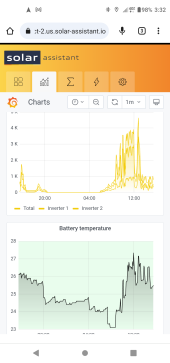lawful-nervous
New Member
- Joined
- Aug 17, 2022
- Messages
- 34
TL;DR: Batteries are getting warm (34°C) but not hot. How warm is too warm and are my batteries safe to use?
---
Charging 2 206aH 12v SOK batteries using the factory settings on the Victron MultiPlus.
Both the batteries and the inverter are a little warm to the touch, but not so hot that I can't comfortably touch them. ABC-BMS app says the batteries are at 34°C.
The positive cables in the batteries (0/1 gauge, less than a foot in length) are similarly warm to the touch. The negative cables and the cables to the inverter are all cool.
The batteries were recently deeply discharged from being in storage too long. I managed to revive them but am a little concerned about their safety.
Is this normal? How warm is too warm?
(Sorry if this has already been asked before. Google was only giving me results about heated LiFePO4 batteries or batteries that got very hot.)
---
Charging 2 206aH 12v SOK batteries using the factory settings on the Victron MultiPlus.
Both the batteries and the inverter are a little warm to the touch, but not so hot that I can't comfortably touch them. ABC-BMS app says the batteries are at 34°C.
The positive cables in the batteries (0/1 gauge, less than a foot in length) are similarly warm to the touch. The negative cables and the cables to the inverter are all cool.
The batteries were recently deeply discharged from being in storage too long. I managed to revive them but am a little concerned about their safety.
Is this normal? How warm is too warm?
(Sorry if this has already been asked before. Google was only giving me results about heated LiFePO4 batteries or batteries that got very hot.)
Last edited:



